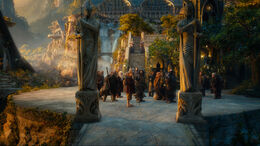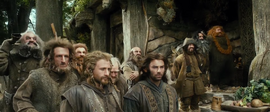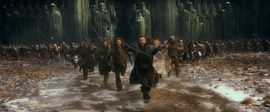Thorin and Company were a group of thirteen Dwarves, the Wizard Gandalf, and the Hobbit Bilbo Baggins, led by Thorin II in TA 2941. Their purpose was to regain the lost Dwarven kingdom of the Lonely Mountain from the dragon Smaug.
Background
The formation of the group grew out of a meeting Gandalf had with Thorin in Bree which kindled Thorin's interest in recapturing his long lost family inheritance. (Thorin's grandfather had been the King under the Mountain when Smaug came and took it.) Remembering that he had once known an adventurous Hobbit on his travels in the Shire, Gandalf decided to add Bilbo to their company because he knew that stealth and cunning were preferable to force. Gandalf also believed that someone like Bilbo could keep the sometimes prideful and stubborn Dwarves from rash action. The superstitious Dwarves also considered thirteen to be an unlucky number, and as Gandalf had planned to leave on other business, welcomed a fourteenth to fill into their party.
History

Formation
On April 26, 2941, Gandalf and the Dwarves arrived at Bag End. After a big tea and supper with Bilbo, they explained themselves and their intentions. Bilbo was at first reluctant to join the group, until the adventurous, 'Tookish' part of him awoke, and he left and followed the company.
Travels & encounters
After traveling for some time and crossing the river Hoarwell, the company were caught and nearly killed and eaten by three hungry trolls. Gandalf returned in time to keep the monsters occupied until dawn, at which the light of the Sun turned the trolls to stone. Recovering themselves, the Dwarves found that these trolls had a cave nearby filled with stolen weapons, food, and a small treasure. Amongst the many weapons were Sting (which Bilbo armed himself with, and which he named after a battle with a giant spider), Orcrist (claimed by Thorin), and Glamdring (taken by Gandalf). Remarkably, all were ancient Elvish blades that had been forged several millennia earlier, in the First Age in Gondolin.

Reaching Rivendell in June, the company held talks with Elrond and learned about the secret Moon-letters on Thorin’s old map of the Lonely Mountain. Elrond also read the runes on the blades of Orcrist and Glamdring, thus identifying them. After spending a short time there, the group resumed their journey over the Misty Mountains.
On their way through the High Pass, the company (minus Gandalf) were captured by Orcs. Taken before the Great Goblin, they were in mortal danger. Gandalf suddenly appeared and killed the Great Goblin, creating enough disarray for them to escape. Unfortunately, Bilbo fell down a hole and was left behind during their hasty retreat. Wandering lost and alone in the depths of the mountain, he found the One Ring and met Gollum, described in The Hobbit as "a small slimy creature … as dark as darkness, except for two big round pale eyes in his thin face."
After a hazardous game of Riddles with the creature, Bilbo fortuitously discovered the Ring he had found could make him invisible. Wearing the Ring, Bilbo escaped Gollum and a group of orcs guarding the eastern door out of the caverns and soon reunited with his companions. Collecting themselves, the company made their way down the mountainside, where they were attacked by Wargs and forced to seek refuge in the trees. Orcs soon arrived and tried to kill the company by getting them down on the ground by tampering down the trees. With all hope nearly gone, the hapless company was rescued by a group of giant Eagles.

After thanking the Eagles, Thorin and Company made for Beorn's house where they managed to impress the wary skin-changer. Fully stocked and prepared the Company, they left Beorn's home and made for Mirkwood. When they reached the edge of the perilous wood, Gandalf announced that he had pressing business elsewhere and would not be coming with them through the forest. Grumbling, they went on ahead, taking the Elf-path into the darkness of Mirkwood. After a few days, they reached a dark stream which Beorn had warned them not to drink or bathe in, for it was enchanted and caused great drowsiness and forgetfulness. They were able to cross it, but Bombur fell in. By the time they fished him out he was already asleep and had to be carried by the rest of the company.
Eventually, they reached a point where they were practically out of food and tried to beg from a group of feasting Wood-elves. Thorin was captured by these Elves, while the remaining company, with the exception of Bilbo, were snared by Giant Spiders. Bilbo rescued them with the help of his magic ring, but they were soon captured by the angry Elves and imprisoned by their king.
With the aid of the ring, Bilbo eluded the Dwarves' captors. Weeks later, he found a way to free them. Hiding in empty wine barrels, the company made their way down the Forest River to Lake-town. There they were fed and clothed with the hope that they would defeat Smaug and regain prosperity for the region.
They reached the mountain after a few days and tried to locate the Side-door described on Thrór's Map. They found it with the help of a Thrush. Thorin decided to have Bilbo enter the mountain and "burgle" something. This the hobbit did and even had a conversation with the mighty Smaug (while wearing the Ring, so that he could not be seen). But the enraged dragon soon emerged and attacked Lake-town, leaving Thorin and Company free to enter the mountain. Meanwhile, the dragon was slain by Bard of Lake-town, but the town suffered great loss and destruction. The Dwarves remained inside the mountain until an army of Lake-men, and later Wood-elves, led by the Elven-king, arrived seeking a share of the treasure to compensate them for their losses. Thorin refused, and the Dwarves were besieged within the mountain. They called for aid from their kin in the Iron Hills (a range to the east of the Lonely Mountain).
The Battle of Five Armies and dissolution of the Company

Just before they were about to fight the Elves, the company were joined by an army of Dwarves from the Iron Hills led by Dáin Ironfoot. Then Gandalf arrived, just in time to inform them that an army of Orcs and Wargs were coming to attack. The Battle of Five Armies began and Thorin and Company went to war. Bilbo stayed out of the battle with the aid of the Ring. The enemy had the upper hand until the arrival of the Eagles and Beorn. The company and their allies won but Fíli and Kíli had been killed and Thorin was mortally wounded. Bilbo bade farewell to Thorin as he lay dying and then left with Gandalf and a modest share of the treasure.[1][2]
Legacy
The deeds of Thorin and Company led to the restoration of the Dwarven Kingdom of the Lonely Mountain and the kingdom of Dale, the rebuilding of Lake-town, and restoration of peace and prosperity in the immediate area for many years. In the long term, the journey of Thorin and Company and the situations it created led to the Council of Elrond and the formation of the Fellowship of the Ring many years later and played a major part setting in motion in the events of the War of the Ring.
Their accomplishments crippled the power of the northern Orcs and removed Smaug as a threat, such that later, Sauron would have fewer minions to call upon during the War of the Ring. Glóin's son, Gimli, would later be a member of the Fellowship of the Ring, contributing to their ultimate victory. Additionally, Bilbo's finding of the Ring would bring it into the care of Frodo, who would one day bring it to its destruction.
Members
- Thorin II Oakenshield (leader)
- Fíli
- Kíli
- Óin
- Glóin
- Balin
- Dwalin
- Ori
- Dori
- Nori
- Bifur
- Bofur
- Bombur
- Gandalf (wizard)
- Bilbo Baggins (burglar)
| Name | Age (TA 2941) |
|---|---|
| Thorin | 195 |
| Fíli | 82 |
| Kíli | 77 |
| Oín | 167 |
| Glóin | 158 |
| Balin | 178 |
| Dwalin | 169 |
| Ori | Unknown |
| Dori | Unknown |
| Nori | Unknown |
| Bifur | Unknown |
| Bofur | Unknown |
| Bombur | Unknown |
| Bilbo | 50 |
| Gandalf | Immortal |
| Name | ||||||||||||||
|---|---|---|---|---|---|---|---|---|---|---|---|---|---|---|
| Dwalin | ||||||||||||||
| Dori | ||||||||||||||
| Nori | ||||||||||||||
| Glóin | ||||||||||||||
| Bifur | ||||||||||||||
| Bofur | ||||||||||||||
Bombur
|
Individual characteristics of the dwarves
Throughout most of The Hobbit, the Dwarves are referred to simply as "The Company," and most do not have individual characteristics that set them apart. However, most Dwarves have at least one scene in which they are personally shown. Several of them have more specialties than others.
- Thorin II Oakenshield is the Leader of the Company, the King of Durin's Folk and former Prince of Erebor, has many of the speaking roles and is known for combat achievements, killing Orcs on countless occasions. He often acts in a confrontational manner, but is a great leader among the Dwarves.
- Fíli and Kíli are nephews of Thorin and the youngest in the Company. They rarely are mentioned without each other. They carry spades and blue hoods, and often sang. They have the sharpest eyes in the Company, and often are look outs for danger. They are killed in the Battle of Five Armies while defending Thorin.
- Balin is one of the kinder Dwarves and has a position of leadership amongst the company. He often takes watch, has royal blood, and is the second eldest. After The Hobbit, he becomes a close friend of Bilbo, and later becomes the Lord of Moria, being slain there by Orcs. His tomb is found in Moria in The Lord of the Rings.
- Dwalin, brother of Balin, is the first of the Dwarves to arrive at Bag End.
- Bombur is the fattest of the Dwarves, and spends most of his time eating and sleeping. He is out of shape, moves slower than the other Dwarves, and frequently complains about being tired. In Mirkwood Forest, he dreams enchanted dreams about food. Following The Hobbit, he becomes so overweight he cannot walk.
- Bofur, brother of Bombur, is not often mentioned individually in the books, but was said to wear a yellow hood.
- Bifur, cousin of Bombur & Bofur, is not often mentioned individually in the books, but like his cousin Bofur, he wore a yellow hood.
- Óin was in charge of lighting fires, along with Glóin. Following The Hobbit, he was killed defending Moria.
- Glóin is known primarily for being the father of Gimli, and accompanying him in Rivendell. When he was in the Company, he and his brother Óin often were in charge of lighting fires.
- Dori is the strongest Dwarf in the company and often had to carry Bilbo around. He is stubborn, yet described as a "decent fellow." He is one of the more cultured Dwarves.
- Ori is one of the youngest in the Company and is inexperienced in combat. Following The Hobbit, he was killed while defending Moria from Orcs.
- Nori is only mentioned individually a single time, when he notices Bilbo is missing after an Orc attack.
In adaptations
Translations
| Foreign Language | Translated name |
| Afrikaans | Thorin en Maatskappy |
| Albanian | Thorin dhe Kompanisë |
| Amharic | የቶሪን ኩባንያ |
| Arabic | ثورين والشركة |
| Armenian | Տհորին եւ ընկերությունը |
| Azerbaijani | Thorinın Şirkətin |
| Bengali | থোরিন ও তার দল |
| Basque | Thorin eta Enpresa |
| Belarusian Cyrillic | То́рын і Кампанія |
| Bosnian | Thorin i Tvrtka |
| Bulgarian Cyrillic | Торин и компания |
| Catalan | Companyia de Thorin |
| Cebuano | Thorin ug Mga kauban |
| Chinese | 索林及其跟随者 |
| Cornish | Thorin ha Felshyp |
| Croatian | Thorin i Tvrtka |
| Czech | Thorin a Společnost |
| Danish | Thorin og Virksomhed |
| Dutch | Thorin en Metgezellen |
| Esperanto | Thorin kaj Kompanio |
| Estonian | Thorin ja Ettevõtte |
| Faroese | Thorin og Handilshús |
| Fijian | Thorin kei na Kabani |
| Filipino | Thorin at Kumpanya |
| Finnish | Thorin ja seurue |
| French | Compagnie de Thorin |
| Galician | Thorin e Compañía |
| Georgian | თორინ და კომპანია |
| German | Thorin und Unternehmen |
| Greek | Θόριν και της Εταιρείας |
| Gujarati | થોરિનની કંપની |
| Hebrew | תורין ושותפיו |
| Hindi | थोरिन एंड कंपनी |
| Hmong | Thorin thiab Niaj hnub |
| Hungarian | Thorin és társai |
| Icelandic | Thorin og Fylgdarlið |
| Indonesian | Thorin dan Kawan-kawan |
| Irish Gaelic | Thorin agus Cuideachta |
| Italian | Thorin e la sua Compagnia |
| Japanese | トーリンと会社 |
| Javanese | Thorin lan Perusahaan |
| Kannada | ಥೋರಿನ್ ಮತ್ತು ಕಂಪನಿ |
| Kazakh | Ториннің компаниясы (Cyrillic) Torïnniñ kompanïyası (Latin) |
| Kyrgyz Cyrillic | Ториндин коому |
| Latin | Thorinus et Cum ? |
| Latvian | Thorin un Sabiedrība |
| Lithuanian | Thorin ir kompanija |
| Luxembourgish | Thorin a Betrib |
| Macedonian Cyrillic | Торин и компанија |
| Malagasy | Thorin sy ny Orinasa |
| Malaysian | Thorin dan Syarikat |
| Maltese | Thorin u Kumpannija |
| Maori | Thorin me Kamupene |
| Marathi | ठोरिन आणि कंपनी |
| Mongolian Cyrillic | Торины болон Компанийн |
| Nepalese | ठोरिन र कम्पनी |
| Norwegian | Thorin og Selskap |
| Pashto | طهورین او د شرکت د |
| Persian | تورین و شرکاء |
| Polish | Kompania Thorina |
| Portuguese | Thorin e Companhia |
| Punjabi | ਠੋਰਿਨ ਅਤੇ ਕੰਪਨੀ |
| Romanian | Thorin și Compania |
| Russian | Торин и компании |
| Samoan | Thorin ma Kamupani |
| Sardinian | Thorin e Cumpangia |
| Scottish Gaelic | Thorin agus Companaidh |
| Serbian | Торин и компанија (Cyrillic) Тоrin i Kompanija (Latin) |
| Sicilian | Thorin e Cumpagnia |
| Sindhi | ٿورين ۽ ڪمپني |
| Sinhalese | එලීජා සහ සමාගම |
| Slovak | Thorin a družina |
| Slovenian | Thorin in Družba |
| Somali | Thorin iyo Shirkadda |
| Spanish | Thorin y Compañía\Compañia de Thorin |
| Sundanese | Thorin jeung Pausahaan |
| Swahili | Thorin na Kampuni |
| Swedish | Torin och Företag |
| Tajik Cyrillic | Ширкати Торин |
| Tamil | தோரின் மற்றும் நிறுவனத்தின் |
| Telugu | థోరిన్ యొక్క కంపెనీ |
| Thai | ธอรินโอ และ บริษัท |
| Turkish | Thorin'in Kafilesi |
| Turkmen | Thoriniň Kompaniýasy |
| Ukrainian Cyrillic | Торін і Компанія |
| Urdu | توران اینڈ کمپنی |
| Uzbek | Ториннинг Компанияси (Cyrillic) Torinning Kompaniyasi (Latin) |
| Venetian | Thorin e Compagnia |
| Vietnamese | Thorin Khiên sồi |
| Welsh | Thorin a Chwmni |
| Yiddish | טהאָרין און פֿירמע |
| Yoruba | Thorin ati Ile |
References
- ↑ The Hobbit
- ↑ The Atlas of Middle-earth, The Hobbit
| Thorin and Company | |
|---|---|
| Thorin II • Balin • Dwalin • Fíli • Kíli • Dori • Nori • Ori • Óin • Glóin • Bifur • Bofur • Bombur • Gandalf • Bilbo Baggins | |
